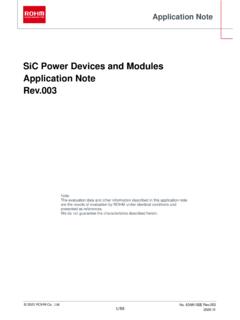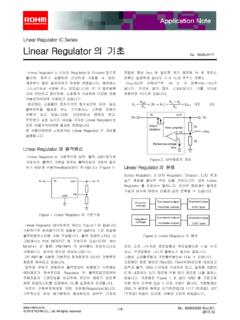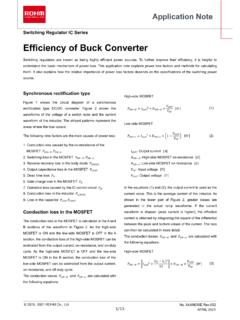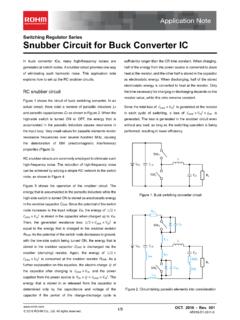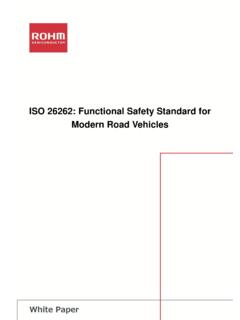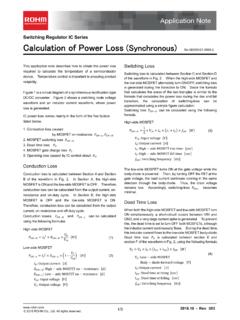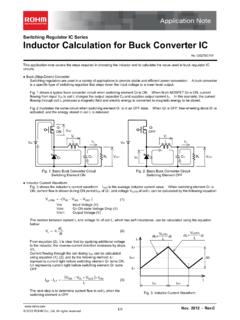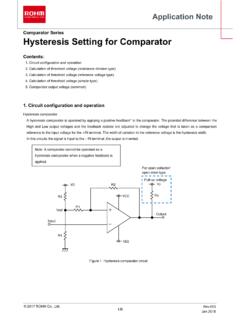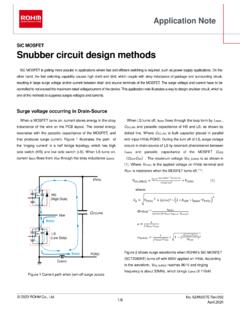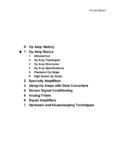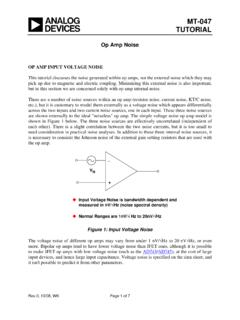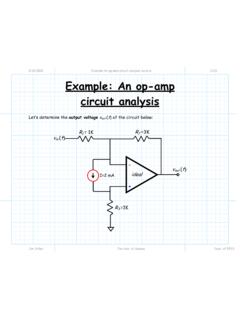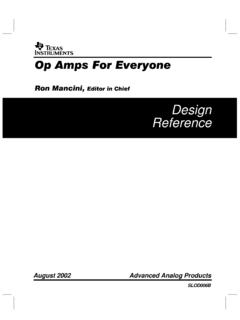Transcription of Op-Amp/Comparator Application Note - Rohm
1 1/51 Application Note 2011 ROHM Co., Ltd. 64AN070E Application Note Operational amplifier ,Comparator (Tutorial) This Application note explains the general terms and basic techniques that are necessary for configuring Application circuits with op-amps and comparators . Refer to this note for guidance when using op-amps and comparators . a Contents 1 What Is Op-Amp/Comparator ? .. 2 What is op-amp? .. 2 What is comparator? .. 3 Internal circuit configuration of Op-Amp/Comparator .. 4 2 Absolute Maximum Rating .. 5 Power supply voltage/operating range of power supply voltage .. 5 Differential input voltage .. 6 Input common-mode voltage.
2 7 Input current .. 8 Operating temperature range .. 8 Maximum junction temperature, storage temperature range .. 8 Power dissipation (total dissipation) .. 9 3 Electrical Characteristics .. 10 Supply current .. 10 Input offset voltage .. 12 Input bias current and input offset current .. 16 Input common-mode voltage range .. 18 Maximum output voltage (High/Low level output voltage .. 20 Large signal voltage gain (open loop gain) .. 22 CMRR (Common Mode Rejection Ratio).. 23 PSRR (Power Supply Rejection Ratio) .. 27 SR (Slew Rate) .. 30 Frequency characteristics of op-amp .. 31 Phase delay and oscillation.)
3 33 Cause of phase delay in op-amp .. 35 Stability confirmation method (amplifier circuit) .. 36 Stability confirmation method (unity feedback circuit/voltage follower) .. 37 Summary of stability confirmation method .. 38 Countermeasures against oscillation by load capacitance (output isolation resistor 1) .. 38 Countermeasures against oscillation by load capacitance (output isolation resistor 2) .. 39 THD+N (Total Harmonic Distortion + Noise) .. 40 Input referred noise .. 44 Response time (rise/fall times and propagation delay time).. 48 4 Reliability Items .. 50 Electrostatic Breakdown Voltage (ESD Breakdown Voltage).
4 50 Latch Up Test .. 51 2/51 Application Note Op-Amp/Comparator Tutorial 2011 ROHM Co., Ltd. 64AN070E What is Op-Amp/Comparator ? What is op-amp? An op-amp (operational amplifier) is a differential amplifier that has high input resistance, low output resistance, and high open loop gain. Its function is to amplify the differential voltage between the + input terminal (non-inverting terminal) and the - input terminal (inverting terminal). Each op-amp circuit is composed of five terminals: a power supply terminal on the positive side, a power supply terminal on the negative side, a + input terminal, a - input terminal, and an output terminal.
5 (There are no general terms for the terminals except classifications such as power source, input and output.) Table Examples of names for op-amp power supply terminals Bipolar type CMOS type Power supply terminal on the positive side VCC VDD Power supply terminal on the negative side VEE VSS Providing high input resistance (impedance) and low output resistance is a function required for the op-amps. In Figure Model of voltage controlled voltage source amplifier (op-amp), VS is the input signal source, RS is the signal source output resistor, Ri is the input resistor of the op-amp, RO is the output resistor of the op-amp, RL is the load resistor, and AV is the amplification factor of the op-amp.
6 The relation between the input and output voltages is described in the equation ( ). ( ) As shown in Figure and the equation ( ), the signal voltage VS is divided into resistance voltages by the signal source resistor RS and the input resistor Ri of the op-amp. As a result, the input signal to the op-amp is attenuated. However, when the Ri is sufficiently larger than the RS (Ri = ), the first term in the equation ( ) can be approximated by 1 and it can be considered that VS = Vi. Next, as for the second term, the amplified input voltage AVVi is divided by the output resistor RO of the op-amp and the load resistor RL and output in Figure Here, the signal can be output without being attenuated if the RO is sufficiently smaller than the RL (RO=0) because the second term can be approximated by 1.
7 Such an op-amp is called an ideal op-amp. Usually, op-amps with high input resistance and low output resistance are preferred. The circuit configuration is designed to achieve an ideal op-amp as closely as possible. Table Ideal input and output resistances required for op-amp Input resistance Output resistance Ideal op-amp (Voltage controlled voltage source) 0 Figure Op-Amp/Comparator symbol Figure Model of voltage controlled voltage source amplifier VSRSViRiAVViROVORLP ower supply terminal on the positive side (VCC) Power supply terminal on the negative side (VEE) Output (OUT) + input terminal (+IN) - input terminal (-IN) LOLVSSiiORRRAVRRRV 3/51 Application Note Op-Amp/Comparator Tutorial 2011 ROHM Co.
8 , Ltd. 64AN070E +VOUTAVVSVIN-An op-amp amplifies a small differential voltage between the + input terminal and - input terminal and outputs the amplified voltage. For this purpose, an op-amp with a large amplification factor is preferred. The reason is explained using the voltage follower circuit in Figure A voltage follower circuit is a circuit in which the input and output voltages are equal. It is mainly used as a voltage buffer. This circuit provides characteristics such as high input resistance and low output resistance, as mentioned above. In Figure , the input voltage VS and the VOUT become identical.
9 Figure Voltage follower circuit Since the op-amp amplifies the differential voltage between the terminals by the amplification factor of the op-amp, the output voltage is expressed with the equation ( ). ( ) The equation ( ) is converted to the equation ( ). ( ) In the equation ( ), when the open loop gain of the op-amp is sufficiently high, the left side can be approximated by 0 and the equation gives VS = VOUT. When the gain is low, the left side of the equation ( ) cannot be approximated by 0 and the output voltage will contain an error. An op-amp with a high open loop gain is desirable because the error in the output voltage can be minimized by the high gain.
10 From another point of view, the high open loop gain means that the difference in the potentials between the + input terminal and the - input terminal is minimized. Namely, the higher the open loop gain is, the better the relation VIN+ = VIN- holds. This relation in which the potentials of the + input terminal and the - input terminal become nearly equal is called a virtual short-circuit, imaginary short-circuit, or virtual grounding. When configuring and using a negative feedback circuit, this relation is realized and Application circuits are designed utilizing the characteristic of the virtual grounding.
